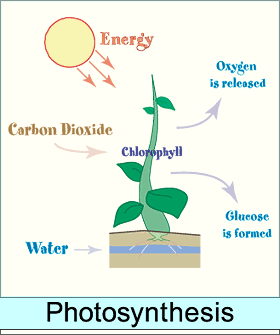How does the Trillium eat?
Unlike humans, animals, and other living organisms, plants do not ingest their food. They rely on a chemical process called photosynthesis accompanied with the uptake of nutrients from the soil.
The Trillium requires above and below ground structures to obtain resources.
 Below ground the
Trillium has roots. These roots grow both
laterally, deep into the soil, and horizontally, branching out from
the plant just underneath the soil in all directions. Roots
take up important minerals and water.
Below ground the
Trillium has roots. These roots grow both
laterally, deep into the soil, and horizontally, branching out from
the plant just underneath the soil in all directions. Roots
take up important minerals and water.
Many of the minerals are taken up via a process called active transport. Active transport is a process that takes place on the membranes of the epidermal cells of a plant in which an H+ gradient is formed. This allows plants to absorb molecules such as K+ and sucrose (a sugar).
Water is absorbed by the roots due to water potential. This means that water moves into the cells of the Trillium root due to a higher concentration of solutes inside the cell.
Once the water and now dissolved minerals enter the cell they travel toward the xylem via intracellular pathways called the apoplast (connections between cell walls) and the symplast (continuous, connected cytoplasm). The xylem is in the interior of the root and stem. It transports water and minerals to the upper parts of the plant due to transpiration and cohesion. Transpiration is the loss of water vapor from a leaf. Cohesion is the connection of water molecules to each other due to hydrogen bonds.
Water can be imagined as a long string of connected molecules. As one is lost to transpiration another molecule is pulled along to fill its place. This pull is felt all the way down the string of molecules to the roots where another molecule will be taken in.
Above ground the Trillium has photosynthetic leaves that play a major role in plant nutrient uptake. Photosynthesis is a process in which plants convert sunlight to food energy.
 Photosynthesis requires three things to occur, light energy,
water, and carbon dioxide.
Photosynthesis requires three things to occur, light energy,
water, and carbon dioxide.
1. Light energy- All green parts of the Trillium are photosynthetic. The green color is due to the presence of chlorophyll, which, is a green pigment within the chloroplasts. Chlorophyll absorbs energy from the sunlight.
2. Water- As previously stated water is taken in by the roots of the plant and transported to the areas in which it is needed
3. Carbon Dioxide- Leaves contain small pores called stomata. Stomata are constructed of two guard cells. When the guard cells have adequate water they bow outward causing an opening for gas exchange. Thus, carbon dioxide enters the leaf.
Light energy, carbon dioxide, and light energy combine to make oxygen gas, water, and, most importantly, sugar (usually in the form of glucose or sucrose).
Sugar is a source of energy for a plant and is therefore needed in all parts. After being produced inside of the chloroplast the sugars travel through a cells via the apoplast or symplast until they reach the phloem towards the center of the leaves and stem. Phloem is very similar to the xylem; their main difference is the direction of transport. While xylem transports nutrients up the plant, phloem transports nutrients to any part of the plant that needs it in any direction.
Phloem is pulled in the direction it is needed by both gravity and pressure. When sugar is needed in a certain structure of a plant it creates a need or pull while the production of sugar creates a push. This creates a favorable pressure in the direction the phloem is needed. Gravity also pulls the phloem down the plant, which, is the general direction it is meant to travel.
These sugars usually combine to make the molecule cellulose, which is important in growing parts of the plant. Non-photosynthetic parts of the plant that cannot produce their own sugar such as roots, seeds, and fruits are the main receivers of the phloem.
Back to Habitat and Geography - Continue to Reproduction
